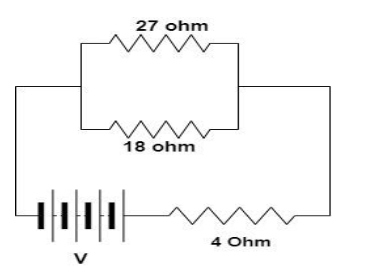
If a potential difference across 27-ohm resistor in the circuit shown is 54 volts, then the potential difference across the 4-ohm resistor is:

1) 20 volts
2) 10 volts
3) 5 volts
4) 4 volts

Answer
479.4k+ views
Hint:In a parallel circuit the voltage remains same in each of the resistance, so here the voltage across 27 ohm and 18 ohm resistance will be the same. Apply the formula of Ohm’s and find the asked voltage across the 4 ohm resistor.
Complete step by step solution:
Ohm’s law is given as:
V = IR;
Where:
V = voltage;
I = current;
R = Resistance;
Now, we know that to calculate equivalent resistance in parallel the formula is:
Put the given value in the above relation:
Do, the necessary calculation and solve:
Now, apply Ohm's law:
V = IR ;
Write the above relation in terms of current “I”:
Put the value of voltage and resistance:
Do the needed calculation:
Now, we know the current that passes through both the resistances combined, again applying ohm’s law to find the voltage across the 4 ohm resistor.
Put the value of voltage and resistance:
The voltage across the 4 ohm resistor is:
Final Answer:Option “1” is correct. Therefore, the potential difference across the 4-ohm resistor is 20 volts.
Note:Here, in case of calculating the equivalent resistance in parallel the formula is
Complete step by step solution:
Ohm’s law is given as:
V = IR;
Where:
V = voltage;
I = current;
R = Resistance;
Now, we know that to calculate equivalent resistance in parallel the formula is:
Put the given value in the above relation:
Do, the necessary calculation and solve:
Now, apply Ohm's law:
V = IR ;
Write the above relation in terms of current “I”:
Put the value of voltage and resistance:
Do the needed calculation:
Now, we know the current that passes through both the resistances combined, again applying ohm’s law to find the voltage across the 4 ohm resistor.
Put the value of voltage and resistance:
The voltage across the 4 ohm resistor is:
Final Answer:Option “1” is correct. Therefore, the potential difference across the 4-ohm resistor is 20 volts.
Note:Here, in case of calculating the equivalent resistance in parallel the formula is
Recently Updated Pages
Master Class 12 Economics: Engaging Questions & Answers for Success

Master Class 12 Maths: Engaging Questions & Answers for Success

Master Class 12 Biology: Engaging Questions & Answers for Success

Master Class 12 Physics: Engaging Questions & Answers for Success

Master Class 4 Maths: Engaging Questions & Answers for Success

Master Class 4 English: Engaging Questions & Answers for Success

Trending doubts
Give 10 examples of unisexual and bisexual flowers

Draw a labelled sketch of the human eye class 12 physics CBSE

a Tabulate the differences in the characteristics of class 12 chemistry CBSE

Differentiate between homogeneous and heterogeneous class 12 chemistry CBSE

Why is the cell called the structural and functional class 12 biology CBSE

Differentiate between insitu conservation and exsitu class 12 biology CBSE




